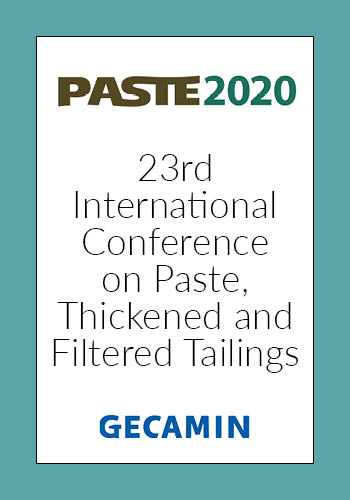Use of paste Fill on cycle at Turmalina Mine

|
Authors: Santana, J; Andrade, E; Milagres, L; Balbys, V |
DOI https://doi.org/10.36487/ACG_repo/2052_60
Cite As:
Santana, J, Andrade, E, Milagres, L & Balbys, V 2020, 'Use of paste Fill on cycle at Turmalina Mine ', in H Quelopana (ed.), Paste 2020: 23rd International Conference on Paste, Thickened and Filtered Tailings, Gecamin Publications, Santiago, https://doi.org/10.36487/ACG_repo/2052_60
Abstract:
Turmalina Mine has been unsuccessful on mining a high-grade thick zone of its orebody using a sublevel stoping bottom-up sequence with rock fill by having high dilution and ore losses. Being one of few mines in Brazil with a paste fill plant, Turmalina Mine – that used to paste fill only open stopes in old areas – saw as an alternative using paste fill on a primary and secondary stoping sequence to reduce probability of ground falls and successfully extract ore from the high-grade thick zone without leaving rib pillars, increasing recovery Empirical formulas and Map3D – boundary element numerical method - were used to define needed plug and mass fill strengths to reduce risk of liquefaction, to use paste filled areas as working platforms and for vertical exposure after secondary mining with low dilution. A binder created for Turmalina tailings considering its rheological characteristics to achieve good flowability and sufficient compressive strength made possible to reach an optimal cycle, combining low binder utilization and sufficient compressive strength for each step of the cycle confirmed by uniaxial compression tests done in specimens with different binder content and ages. Filling consists of a 5% plug fill and then a 3% mass fill after a two days wait for the plug fill to reach 100kPa. Filled stope is ready to serve as a working platform after 3 days, when it reaches 170kPa. Secondary stoping is sequenced after 28 days when mass fill finishes, as it is ready to have a vertical exposure with a strength of over 500kPa. Paste fill specimens collected are tested to confirm the strengths needed before each step. By implementing paste fill in the sublevel stoping sequence, the mine is planning to control operational dilution at a maximum of 15% and increase ore recovery to 95% in the high-grade thick zone.
References:
BELEM, T.; BENZAAZOUA, M. (2008) ‘Design and application of underground mine paste backfill technology’, Geotechnical and Geological Engineering, 26, 147-174.
CRAIG, R.F. (1995) Soil mechanics. Fifth Edition, Chapman and Hill Publishing, London, 427 p.
HANSEN, J. B. (1968) ‘A revised extended formula for bearing capacity’, Danish Geotechnical Institute Bulletin, 28.
HASSANI, F.; BOIS D. (1992) Economic and technical feasibility for backfill design in Quebec underground mines Final report 1/2, Canada-Quebec Mineral Development Agreement, Research & development in Quebec Mines Contract no EADM 1989-1992.
MITCHELL, R. J.; OLSEN, R. S.; SMITH, J. D. (1982) ‘Model studies on cemented tailings used in mine backfill’, Can Geotech, J19(1): 14–28.
YU, T. R. (1992) ‘Mechanisms of fill failure and fill strength requirements’, In: Proceedings of 6th Canadian rock mechanics symposium, Sudbury-ON, 1–6.
© Copyright 2025, Australian Centre for Geomechanics (ACG), The University of Western Australia. All rights reserved.
View copyright/legal information
Please direct any queries or error reports to repository-acg@uwa.edu.au
View copyright/legal information
Please direct any queries or error reports to repository-acg@uwa.edu.au